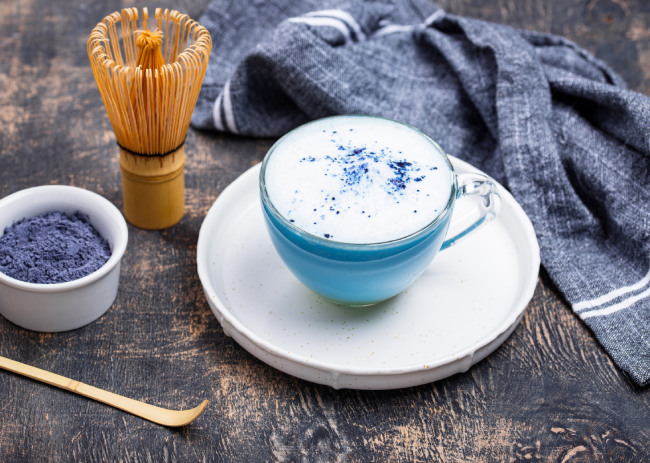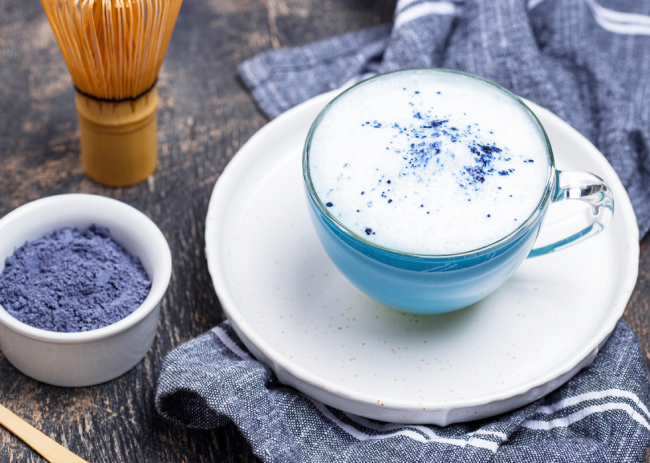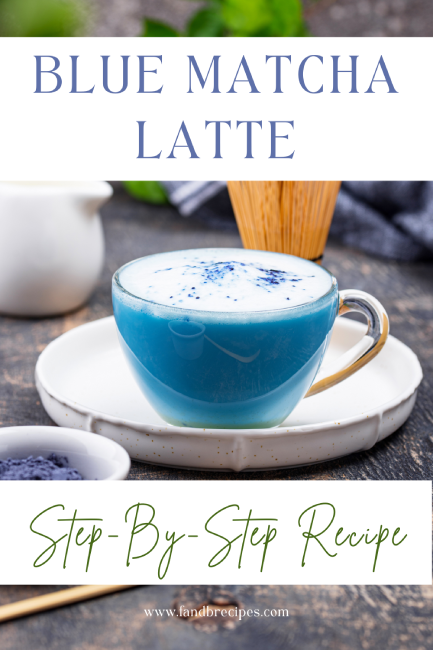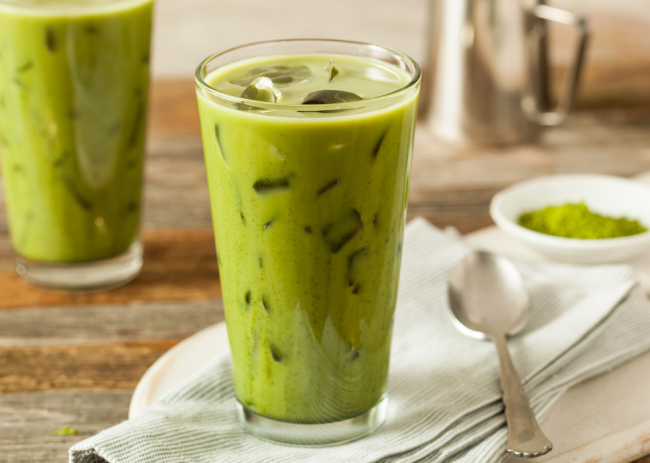Blue Matcha Latte: Step-By-Step Recipe
Have you ever seen a drink from across the room and said to yourself: “I’ll have one of those, please!” A blue matcha latte is one of those drinks, a vibrant blue concoction resembling the waters of a pristine glacial lake. With no caffeine, this calming concoction is a great evening drink packed with antioxidants that won’t keep you awake, unlike other traditional matcha.
Most people have never heard of a blue matcha. Not only is it healthy, but it’s beautiful to look at. It’s also surprisingly easy to make, especially if you’re already familiar with fixing yourself a green matcha! This means you might have everything you need to make it!
What is Blue Matcha Latte?
Blue matcha is technically an herbal latte. Matcha simply means “ground tea” in Japanese. The blue colour comes from the flowers of the blue butterfly pea plant, which are dried and ground into a fine powder and then added to steamed milk to make a latte.
Matcha and blue matcha come from two completely different plants. Traditional matcha comes from the tea plant (Camellia Senesis) and is often associated with green tea, and blue matcha comes from the butterfly pea plant’s (Clitoria Ternatea) flower. Each plant has differences that affect the taste, appearance, and effects of a drink made from it.
One unique property of the butterfly pea flower is the anthocyanins they hold within its petals. Anthocyanins are plant flavonoids in many red, blue, and purple plants. In the case of the blue butterfly pea plant, this gives the flower its rich blue colour and, under the right conditions, can actually change colours right in front of your eyes. In an acidic environment, anthocyanins change from a blue to a bright purple or pink. (Many internet influencers have added lemon juice to provide a bit of “magic” while they film content.)
Blue matcha is also water-soluble, which makes it easier to mix into foods and drinks. Green matcha doesn’t entirely dissolve and will remain as solid pieces when mixed with foods or drinks if not whisked correctly. This is why tea strainers and bamboo whisks are used to mix the match powder with water. Overall, a blue matcha latte has a smoother texture.
Blue Matcha Latte Benefits
The benefits of a blue matcha latte are due to the anthocyanins in the butterfly pea plant. Anthocyanins are powerful antioxidants that scavenge the body and neutralize harmful free radicals. By preventing damage caused by free radicals, anthocyanins in the right concentration have a few of the following potential benefits:
#1. Anti-obesity
Improvement in bad cholesterol and slight weight loss is possible based on recent studies. Obesity carries many health risks, including high blood pressure, cardiovascular disease, and diabetes. All of which can contribute to a decreased quality of life and other health problems. Anthocyanins were shown to increase fat metabolism and decrease fat cell dysfunction when consumed in a concentrated form.
#2. Anti-diabetic
Diabetes consists of chronically elevated blood sugar. Diabetes can cause problems like nerve pain, kidney damage, eye damage, and cardiovascular problems if not controlled. Insulin, which is secreted by the pancreas, helps control spikes in blood sugar. Insulin doesn’t work as well in patients with diabetes. Anthocyanins have been used to increase the amount of insulin the pancreas secretes, helping control blood sugar for longer periods.
#3. Anti-cancer
Cancer has a variety of causes. Some of which are influenced by factors in our environment, and some that are genetic. Reactive oxygen species, or free radicals, can cause damage to the cell wall and DNA over time. When cells must continually repair themselves due to damage from free radicals, there’s an increased risk of mutations, leading to cancers. Anthocyanins have the potential to neutralize free radicals.
#4. Reduce inflammation
Free radicals break down cell walls through a process called lipid peroxidation. When the cell wall breaks down, the inflammatory response is started to repair the damage. Inflammation is not only a response to free radicals, but it also creates more free radicals in the process. Antioxidants work to eliminate harmful free radicals, thereby decreasing inflammation. Diets high in anthocyanins have been shown to decrease the number of inflammatory markers in participants.
#5. Improved eye health
Anthocyanins are important for supporting the health and function of photoreceptors in the eyes. Photoreceptors are what help you see in low light conditions, including at night. Research also showed improvement in eyesight with several glaucoma patients when given high concentrations of anthocyanins.
#6. Improved cardiovascular health
Anthocyanins may decrease the risk of developing blood clots, which could lead to a stroke. Cultures around the world that have high levels of anthocyanin-rich foods in their diet have lower rates of cardiovascular disease. Foods high in anthocyanins also can lower bad cholesterol, a contributing factor to heart attack and stroke. Adding anthocyanins to your diet may help reduce your risk of cardiovascular complications.
#7. Cognitive improvement
Many consumers have reported drinking blue matcha improves their cognitive function, including memory. Evidence suggests that anthocyanins can improve the function of the blood-brain barrier and mitochondrial function in the central nervous system. Mitochondria is the powerhouse of the cell and may improve cognition when functioning optimally. Anthocyanins have also shown a protective and regenerative effect on nerves, including the spinal cord.
The flower of the butterfly pea plant has been used for centuries by civilizations in the Asian-Pacific region for its purported health benefits. As you can see, blue matcha and the anthocyanins it holds have many potential health benefits.
This doesn’t mean blue matcha is a cure for conditions like obesity, cardiovascular disease, or cancer. However, adding blue matcha to your daily routine may help you become a healthier version of yourself.
Ingredients Required to Make a Blue Matcha Latte
You’ll need only a few easy-to-get ingredients.
- 1 cup milk of your choice
- ½ -1 teaspoon butterfly pea powder
- ½ tablespoon pure maple syrup or sweetener of choice
Optional ingredients include:
- ¼ teaspoon vanilla extract
- A pinch of cinnamon
Some people like to experiment with a variety of flavours and textures to make their blue matcha latte even better! Consider using agave nectar, cinnamon, and vanilla to level up your latte.
You can find blue matcha powder online or at speciality food stores.
Essential Items to Make a Blue Matcha Latte
Making a blue matcha latte is a simple and calming ritual. Grab these essentials to get started:
- A bowl or a Chawan (a traditional Japanese tea bowl). Some Chawans have a built-in lip for easy pouring. A small bowl can work just as well, though!
- A matcha whisk. Also called a chasen, this popular matcha tool is crafted from bamboo. This whisk helps get rid of any clumps in the powder.
- A saucepan when you want to heat up your milk.
- A small blender or milk frother for that wonderful latte finish.
- Your favourite mug. Grab your cup of choice, preferably clear glass, so you can see the lovely colour with every sip.
Blue Matcha Latte Recipe
Ready to start making this delicious drink? Here’s how to make this soothing beverage when you’re ready to wind down for the day:
Prep Time: 2-5 min
Cook Time: 2- 5 min
Time required: 5-10 minutes
Serves: 1
Step 1: Warm up your cup of milk. In a small saucepan, heat milk of your choice on medium heat, stirring occasionally, until warm. Be careful not to let it boil. Once heated, transfer the milk to a blender or directly into your cup.
Step 2: Add in your blue butterfly pea powder. Just ½ teaspoon of blue matcha per cup is enough for a perfectly potent drink. Add a little extra if you want more colour and flavour!
Step 3: Add a sweetener and other optional ingredients to the warm milk. We typically enjoy adding around one tablespoon of sweetener per cup of liquid but feel free to adjust to your personal taste preferences.
Step 4: Blend together. We recommend using a blender or a milk frother to ensure thorough mixing and prevent clumping of the blue powder. Whisking or shaking in a jar are also great options. Enjoy the delightful, frothy texture it creates!
Craving something cold?
Add in some ice and enjoy this beautiful drink at a cooler temperature, which is perfect for warmer weather.
Just remember: Once you get more confident making blue matcha, you’ll discover what recipe (and methods) works best for you!
Blue Matcha Latte: Nutritional Information
Blue matcha latte can be a healthy, relatively low-calorie addition to your daily routine. Here is a breakdown of the essential nutritional information:
Calories: 100
Total Fat: 0g
Saturated Fat: 0g
Trans Fat: 0g
Total Carbs: 25g
Net Carbs: 23g
Dietary Fiber: 2g
Total Sugars: 18g
Added Sugars: 18g
Protein: 1g
Cholesterol: 0mg
Sodium: 5mg
Calcium: 10mg
Iron: 0.5mg
Potassium: 40mg
Be mindful that you can add nutritional supplements to this drink if you’d like. Protein powder, for example, will mix nicely with a milk base and make a great addition!
Tips to Make the Best Blue Matcha Latte
You can adjust your preparation or the recipe however you see fit. Here are some general recommendations on making the best drink for you to enjoy.
- Use quality blue matcha powder: Pure butterfly pea flower powder is essential for the anthocyanin content of your latte. Don’t buy anything with fillers or additives that bulk up your product.
- Use the right base: Choose your favourite type of base. Whether that’s oat milk, whole milk, or coconut milk. If the consistency isn’t to your liking, try a different milk base.
- Slowly heat the base: Make sure not to heat the base too quickly or too high. You could end up burning the sugars in the milk and not liking the taste.
- Use a frother: A frother adds a layer of creamy texture that a traditional latte is known for.
- Mix well: Unlike traditional matcha, blue matcha will mix well into milk with a little bit of work. To get a smooth consistency, use a whisk to incorporate.
- Add your favourites: Try different sweeteners like vanilla, agave, or honey. A little cinnamon, nutmeg, or clove is a nice earthy addition to garnish the top.
Storing & Freezing
This beverage can be stored easily if you want to keep more of the mixture on hand. To make this freezer-friendly, simply combine milk, matcha powder, and sweetener in a blender or jar. Blend or shake until well-mixed. Then, pour the mixture into your container and place it in the freezer. For easier pouring, you can transfer the contents of the blender or jar into a liquid measuring cup with a spout.
FAQs:
What Does Blue Matcha Taste Like?
Since the blue matcha is created from the flower of the butterfly pea plant, some describe the taste as a light, earthy flavour like lavender. If the flavour is too bland, you can try adding a bit of honey, maple syrup, or any other natural sweetener.
What Is The Difference Between Green Matcha And Blue Matcha?
Green matcha is actually ground-up tea leaves that have caffeine. Blue matcha doesn’t have any tea leaves in it, so no caffeine.
Green matcha gets its colour from chlorophyll in tea leaves. The plant is grown in the shade to help boost nutrients to become a vibrant green. Blue matcha colour comes from the anthocyanins in the petals of the butterfly pea plant.
In general, green matcha is better in the morning when you need an extra kick of caffeine. Blue matcha is a better choice at the end of the day when you want to relax and unwind.
Does Blue Matcha Have Caffeine In It? Is It OK to Drink Matcha Every Day?
Blue matcha is strictly a herbal drink unless you add other ingredients that may have caffeine.
With most things in life, it’s always good to practice moderation. The good news is that there is no sign of potential toxicity associated with drinking blue matcha regularly. The anthocyanins in blue matcha also have a short half-life. Therefore, blue matcha won’t build up in your body. Half-life is related to how long a substance stays around in your system and deposits into your tissues. Anthocyanins consumed from blue matcha will be eliminated from your body in a few hours.
Since blue matcha doesn’t have caffeine and is excreted quickly, you don’t need to worry about having two or three cups if you really enjoy it!
Is Blue Matcha Healthy?
Blue matcha is packed with potential health benefits that can be enjoyed in multiple ways. People are always looking for natural additions to improve their well-being, and blue matcha is one of those additions. Blue matcha latte is the perfect drink to incorporate into your nightly routine, to relax, unwind, and receive the health benefits from the anthocyanins.
What Are Some Other Ways To Drink Blue Matcha?
Because of blue matcha’s versatility, you’ll be able to create fun drinks with a stunning splash of colour. Here are some of the most popular drink ideas for enjoying blue matcha.
- Iced blue matcha lemonade
- Blue matcha smoothie
- Blue matcha mocktail
- Blue matcha bubble tea
Blue matcha isn’t just for drinking. Since blue matcha is water soluble, it will mix well with any liquid except for oil. Also, blue matcha is widely available in a finely ground power, that will incorporate into solids if mixed well. Here are some of our favourite ways to include blue matcha in decorative edibles and treats:
- Blue matcha ice cream
- Blue matcha berry popsicles
- Blue matcha frosting
- Blue matcha sugar cookies
Add blue matcha to your daily beverages or as a special occasion for decoration. Whatever the occasion, make sure you have some blue matcha powder on hand!
In Conclusion
If you’ve been looking for a healthy alternative to traditional matcha or other caffeinated drinks, blue matcha is a great place to start. Its earthy flavour and versatility are ideal for calming your nerves or wind down after a long, busy day. Try incorporating blue matcha into your latte and experience its many benefits.

Blue Matcha Latte: Step-By-Step Recipe
Equipment
- A bowl or a Chawan
- A matcha whisk
- A Saucepan
- A small blender or milk frother
- Your favourite mug
Ingredients
- 1 cup of milk of your choice
- ½ -1 tsp butterfly pea powder
- ½ tbsp pure maple syrup or sweetener of choice
Optional ingredients
- ¼ tsp vanilla extract
- A pinch of cinnamon
Instructions
- Warm up your cup of milk. In a small saucepan, heat milk of your choice on medium heat, stirring occasionally, until warm. Be careful not to let it boil. Once heated, transfer the milk to a blender or directly into your cup.
- Add in your blue butterfly pea powder. Just ½ teaspoon of blue matcha per cup is enough for a perfectly potent drink. Add a little extra if you want more colour and flavour!
- Add a sweetener and other optional ingredients to the warm milk. We typically enjoy adding around one tablespoon of sweetener per cup of liquid but feel free to adjust to your personal taste preferences.
- Blend together. We recommend using a blender or a milk frother to ensure thorough mixing and prevent clumping of the blue powder. Whisking or shaking in a jar are also great options. Enjoy the delightful, frothy texture it creates!
Notes
- Use quality blue matcha powder: Pure butterfly pea flower powder is essential for the anthocyanin content of your latte. Don’t buy anything with fillers or additives that bulk up your product.
- Use the right base: Choose your favourite type of base. Whether that’s oat milk, whole milk, or coconut milk. If the consistency isn’t to your liking, try a different milk base.
- Slowly heat the base: Make sure not to heat the base too quickly or too high. You could end up burning the sugars in the milk and not liking the taste.
- Use a frother: A frother adds a layer of creamy texture that a traditional latte is known for.
- Mix well: Unlike traditional matcha, blue matcha will mix well into milk with a little bit of work. To get a smooth consistency, use a whisk to incorporate.
- Add your favourites: Try different sweeteners like vanilla, agave, or honey. A little cinnamon, nutmeg, or clove is a nice earthy addition to garnish the top.




